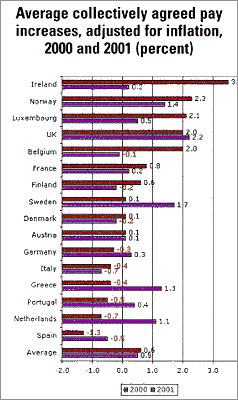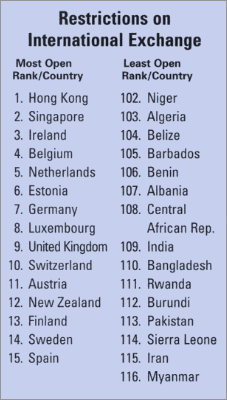As Rest of World Shuffles, China Sprints
Even amid widespread concern about too much reliance on China as the new industrial powerhouse, the capital and projects just keep coming.
Foreign investment totaled some $45 billion last year. In Shanghai alone, overseas-funded firms exported more than $7 billion worth of products during the first five months of this year, according to the Shanghai Municipal Foreign Trade and Economic Cooperation Commission. That’s a quantum leap from 1991, when the annual total was a mere $645 million. The drive is led by huge growth in the microelectronics field, with Philips, Siemens and Intel leading Shanghai exporters (see “Chips in a Dip,” from September 2002). Intel broke ground on a $198-million assembly and test plant in 1995 in Shanghai, expanded it with $300 million more, and has recently announced, even in the face of worldwide belt-tightening, a further $100-million expansion of the facility.
But other partnerships are also fueling the frenzy, even among Asian rivals. South Korean giant Hyundai will partner with Beijing Automotive Industry Holding Co., initially pouring $100 million into a venture it plans to invest $430 million into by 2005, when it hopes the plant will be producing 200,000 cars annually. Honda plans to double the output of the plant it operates with Denway Motors’ Guangzhou Automobile Group. Toyota and Nissan are seeking to follow suit with Tianjin Automotive and Dongfeng Motor Corp. respectively. And Mitsubishi plans to make SUVs at the Chinese plant owned by partner DaimlerChrysler.
Taiwan’s Formosa Plastics Group will be teaming up with Hon Hai Precision Industry Co. to produce automotive components and parts on the mainland. Canada’s Alcan is buying a 50 percent interest in the 130,000-ton smelter owned by Qingtongxia Aluminum Co., which already has approved plans in place to more than double its capacity in the Ningxia Autonomous Region. German specialty chemical company Degussa AG is investing $35 million in a new venture in Beijing.
“The investment company will transform our presence in China from a foreign company exporting to China to a responsible corporate citizen who develops and manufactures products here and exports them to other Asian countries,” said Degussa (China) President Eric Baden. Since 1988, Degussa has opened a total of 11 sites in China with an investment of $80 million.
So it comes as no surprise that the timetable for foreign investor involvement in fast-growing Shenzhen’s special economic zone has been shortened considerably, setting the pace for other zones throughout the country to open up to markets and embrace the multinationals beating down the door. Sectors like financial services, ports, procurement centers and logistics are expected to open to FDI ahead of the timetable set by the World Trade Organization, and to welcome that investment with an array of tax incentives, including rebates for exports.
But many of those goods are staying around. Even personal computer sales, down everywhere else, are expected to rise by some 19 percent this year, mirroring a similar rise in server sales.
What is also still rising, however, is a massive oversupply of labor. According to a survey of 62 cities conducted by China’s Institute for Labor Studies, the number of new job seekers entering the labor market is estimated to reach 12.4 million annually through 2005. And while property development investment rose by 36.7 percent over last year during the first five months of 2002, reaching $25.3 billion, unsold housing increased by 8.2 percent, signaling the pinch felt by that swelling work force.
Such developments haven’t slowed other development however, symbolized most dramatically by the five-year, $42-billion investment by the Chinese government in the nation’s vast rail network. The plan will add 4,400 miles of track to a system that already covers 43,000 miles (69,200 km.). The freight and cargo sector too is gradually allowing foreign investment, and will remove all foreign ownership restrictions by 2006.


England Sees Big Increase in Mini Making,
New Glass Plant in the North
German automotive manufacturer BMW Group has announced plans to invest $80.7 million in its Mini plant in Oxford, in southeast England. Employment at the plant has risen from 2,400 at the launch of the Mini in April 2001 to around 4,500 today.”We had planned to produce 30,000 cars to the end of last year, but the actual figure was more than 42,000,” said Dr Norbert Reithofer, BMW board member for production. As of the end of May, the plant had surpassed the 100,000 mark a mere 13 months into full-volume production.
At the opposite end of the fair island, Michigan-based Guardian Industries has announced plans to construct a $160-million architectural glass manufacturing facility in Goole, East Riding of Yorkshire, that will churn out 700 tons per day when it opens in 2004.
“Guardian chose the North of England as the location for its eighth European float glass facility because of the region’s role as a gateway to international markets,” said Ralph J. Gerson, executive vice president at Guardian Industries.

Minoura Helps Break New Ground for Toyota in Mexico
With a new footprint in Mexico, Toyota has now walked the NAFTA circle.
Mexican President Vicente Fox, Governor Eugenio Elorduy, and Jesus Gonzalez, Presidente Municipal de Tijuana, joined hundreds of community leaders, government officials, and Toyota Motor Manufacturing North America President Teruyuki Minoura in a ceremony June 12 to mark the construction of the automaker’s truck deck plant to be built in Baja, California. It will be the company’s first Mexican facility.
Positioned to make and ship truck beds for the Tacoma pickup trucks assembled just up the road at New United Motor Manufacturing in Fremont, Calif. (a Toyota/General Motors joint venture), the plant is part of Toyota Motor Manufacturing North America’s 2003 goals: capacity to build 1.45 million cars and trucks and 1.6 million engines a year, and employment of some 33,000 people.
“This Mexico facility is an extremely important milestone for us,” said Minoura. “This plant finally closes the Toyota North American manufacturing circle: the U.S., Canada and now Mexico.”
As if to drive home that point, the new president of Toyota Motor Manufacturing de Baja California will be Seiji Ikezaki, who currently holds that same post at Toyota’s oldest North American plant, TABC in Long Beach, Calif.
A further sign of promising horizons in Mexico: Toyota Motor Sales began selling Camrys there in April, with Corollas scheduled to bloom along the autovias this fall.
“It is our basic policy that ‘We make them where we sell them,” said Minoura.
Mexico is not the only Latin American location to see investment from the parent company. Two days later, Toyota announced the completion of a $30-million investment in the expansion of the Indaiatuba Plant of Toyota do Brasil Ltda. (TDB), its manufacturing subsidiary in Sao Paulo, Brazil.
The plant, which has been building Corollas since 1998, now has an annual production capacity of 57,000 units, up from 15,000.
The expansion enlarged the plant’s floor space from 29,000 square meters (312,000 sq. ft.) to 69,000 square meters (743,000 sq. ft.), and includes a new stamping shop. The plan also aims for a two-shift system, anticipated to add as many as 1,000 new jobs to the payroll.
According to the company, the Indaiatuba-made new Corolla will be sold in Brazil and exported to more than 20 countries, including Argentina and Uruguay, helping to establish TDB as a Toyota export base for Latin America.


European Pay Figures Released Against Striking Backdrop
With construction workers stopping work in Germany for the first time since World War II, and other trade unions staging protests and strikes in Spain and France, the European Industrial Relations Observatory has released figures showing the latest trends in colle ctively bargained compensation across the continent.

Among the findings:
The workers concerned received real pay increases in 11 countries in 2000, but in five countries (Belgium, Denmark, Finland, Italy and Spain) they saw their nominal pay increase swallowed up by inflation (although in some cases, the pay increase figures used represent minima, built on by subsequent bargaining). In 2001, the range of real pay increases was between 3.5 percent in Ireland and -1.3 percent in Spain.Over the four-year period 1998-2001, the trends in real pay increases have been variable in all countries except Spain, where there has been a continuous fall. The pattern observed in Belgium, Finland, Ireland, Italy and Norway was for real pay increases to fall over 1998-2000, before experiencing an upturn in 2001. By contrast, in Germany, Greece, Portugal and Sweden, real pay increases rose from 1998 to 1999 but have fallen continuously since. Spain has attracted its share of projects recently, including a $31.5 million investment by Sony Espana in its Barcelona factory, where it plans to invest an additional $12 million in R&D. Ernst & Young recently singled out Barcelona as one of the “Hot Cities” for foreign investment projects, in part because of its lack of dependence on U.S. companies. In conjunction with a re-branding of the country’s economic development efforts to go with its new government, Carlos Tavares, Portugal’s Minister of the Economy, announced in June the reduction of corporate taxes from 30 percent to 20 percent, the second lowest business tax rate in Europe after Ireland. The only catch is that the tax savings thus realized must be reinvested in fixed capital or research and development within the country of Portugal. In line with other red tape reduction efforts worldwide, Tavares also announced the goal of reducing the permitting process to 70 days. Meanwhile, Switzerland’s lowest-of-the-low corporate tax rate of 8 percent was one incentive for homegrown pharmaceutical firm Lonza Group to decide in June to locate a $63.5-million plant in Visp, where it already employs 2,600 people.”Together with the available infrastructure, our broad technological base and the outstanding cooperation of the local authorities made the strongest case for siting this commercial production facility in Visp, canton of Valais,” said Werner Grauwiler, assistant vice president. The new plant will employ 110 people, and will commence production in 2005.


Amsterdam Port Crucial to Landing of Two Facilities
Starbucks Coffee Co. will open its first European roasting and distribution facility at the Westpoint complex in Amsterdam, the Netherlands, by the end of this year. “Amsterdam’s strategic geographical location in continental Europe makes it an ideal home for our facility,” said Mark McKeon, president of Starbucks Coffee Company for Europe, Middle East and Africa, adding that the 94,000-sq.-ft. (8,724-sq.-m.) center will serve hundreds of stores in the region. Starbucks stores in the region with our high quality fresh roasted coffee. Part of the Amsterdam allure is its port facilities, which make the city one of Europe’s top 10 maritime hubs with annual cargo handling of 68 million tons.
Hitachi Construction Machinery just opened its training and demonstration center in the Westhaven portion of the city. The new plant adjacent to the demonstration facility will employ 250 people in making some 3,500 excavators per year. Company officials have indicated that the port will serve as the crucial conduit for both shipping in of supplies and shipping out of finished machines to customers in Europe, Africa and the Middle East.


Countries Ranked On Free And Open Trade
The new edition of “Economic Freedom of the World,” published by Fraser Forum and authored by Florida State University professor James Gwartney and Capital University professor Robert Lawson, ranks 116 countries according to such freedom of exchange signposts as low tariffs, convertible currency and low capital market controls. Besides leading to higher GDP, the authors concluded that open economies also enhance the cultivation of fairer legal systems and more stable currencies. The U.S. had the 23rd most open economy.










